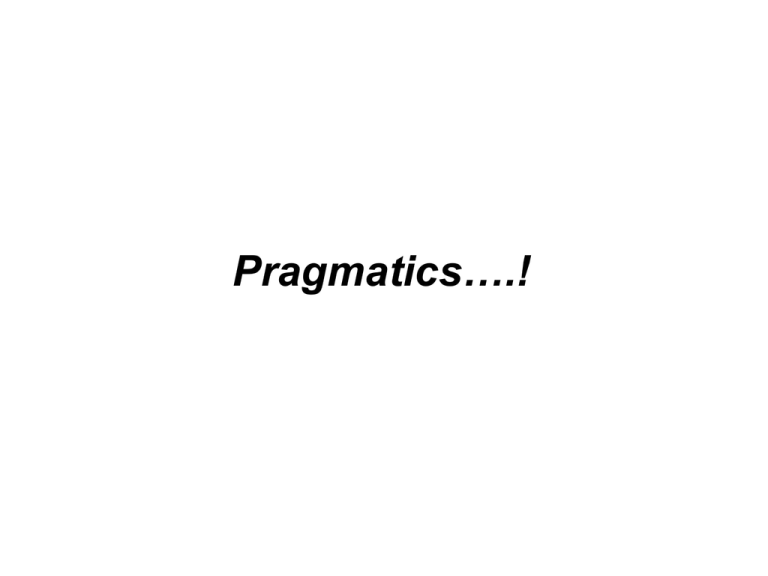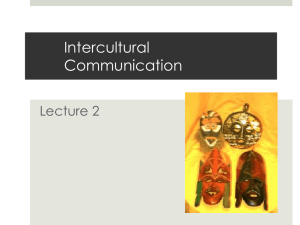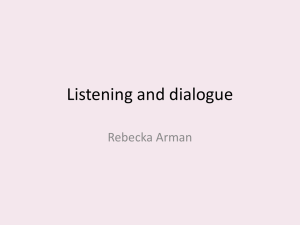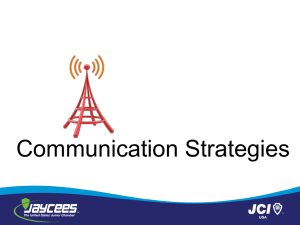Pragmatics Materials
advertisement

Pragmatics….! Contents 1.“The Limits of Language” 2. The Sounds of Language 3. Pragmatic Basics Four conclusions • • • • Language is ambiguous by nature. We must draw inferences about meaning. Our inferences tend to be fixed, not tentative. Our inferences are drawn very quickly. Language is ambiguous by nature • We can never fully control the meanings of things we say and write it is interpreted by our listeners or readers. • What are the three levels of ambiguity? Three levels of ambiguity • Word-level • Sentence-level • Discourse-level Word level ambiguity • “I watched TV” • watched some TV programs (dramas, movies, or news) • not the actual TV monitor itself Sentence level ambiguity • “Do you have any money?” • Can have different meanings: 1. Literally, do you have money (just curious) 2. Do you have money to pay for our coffee 3. Would you mind lending me some money? “Well done!” • Depending on the context of the situation, it can have different meanings. Here are two examples: • At a party if a woman says this to her husband after he breaks an expensive dish by accident she isn’t praising him for doing it, but rather is blaming him for his carelessness. • A teacher says this to her students after good results on a test. Discourse level ambiguity • What is meant by “discourse”? • Written or spoken communication ; especially conversation • From: http://www.merriam-webster.com/dictionary/discourse We must draw inferences about meaning • What are the two main sources that we draw our inferences from? • The language used • Our knowledge about the world Our inferences tend to be fixed, not tentative Our inferences are drawn very quickly Making inferences • Inferences also tend to based on our experiences in our own culture. • We expect other people to behave according to our cultural expectations. TESOL Culture “The Sounds of Language and Introduction to Pragmatics” The Sounds of a Language • Discuss with a partner: • What do we mean by “the sounds of a language”? • Are the sounds of a language and culture related? How? Pronunciation • What is involved in pronunciation? • • • • • • • • Sounds Vowel sounds Consonant sounds Stress Word stress Sentences stress Intonation Rhythm Word Stress Please read the following words out loud when you see them: record contract present Sentence Stress • Please read the following sentence: • That’s not my black umbrella. • Now read the sentence with the word in red stressed. • • • • • That’s not my black umbrella. That’s not my black umbrella. That’s not my black umbrella. That’s not my black umbrella. That’s not my black umbrella. Intonation • Read the following sentence • You’re happy aren’t you? • 1.) with intonation going up • 2.) with intonation going down Rhythm • Read the following sentences and count the number of syllables and the number of beats in each. • • • • Children eat candy. The children eat candy. The children eat the candy. The children have eaten the candy. Discussion • What is pragmatics? • Pragmatics is the study of the ability of natural language speakers to communicate more than that which is explicitly stated. • The ability to understand another speaker's intended meaning is called pragmatic competence. • Pragmatics deals about how to reach our goal in communication. • Pragmatics is regarded as one of the most challenging aspects for language learners to grasp, and can only truly be learned with experience. Pragmatics Defined • Pragmatics is the study of the ability of natural language speakers to communicate more than than they explicitly state. • The ability to understand another speaker's intended meaning is called pragmatic competence. • Pragmatics is regarded as one of the most challenging aspects for language learners to grasp, and can only be fully learned with experience. Discourse • written or spoken verbal communication Conversational Implicature • The meaning is not explicit in the sentence but is implied. • Example: Is it cold in here?” • Meaning: I’m cold; would you close the window? Understanding Implicature • Conversational implicature is about making inferences from what is heard. • According to Grice, there are three things that listeners must understand in order to infer, i.e., make sense of what the speaker is saying. Three things to understand • The usual linguistic meaning of what is said. • Contextual information (shared or general knowledge). • The assumption that the speaker is obeying what Grice calls the cooperative principle Cooperative Principle • To achieve the goal of communication, speakers and listeners must speak cooperatively and mutually accept one another. If speakers and listeners follow Grice’s Conversational Maxims, they can be seen as following the Cooperative Principle of communication. • The cooperative principle includes a set of norms or maxims expected in conversation Gricean Maxims 1. 2. 3. 4. Relevance Truthfulness Quantity Clarity Relevance • Be relevant when you speaking in a conversation. • (i.e., say things related to the current topic of the conversation). Truthfulness • Sometimes referred to as the “Maxim of Quality” • 1. Do not say what you believe to be false. • 2. Do not say that for which you lack adequate evidence. Quantity • Make your contribution to the conversation as informative as necessary. • Do not make your contribution to the conversation more informative than necessary. Only give as much information as needed and no more. (i.e., Don’t talk too much! ) Clarity • 1. 2. 3. 4. Also known as the “Maxim of Manner” Avoid obscurity of expression. Avoid ambiguity. Be brief (avoid unnecessary wordiness). Be orderly. Goffman’s Communication Theory: System contraints • Goffman argued that in addition to Grice’s norms, there are also 7 other universal constraints. Goffman’s Constraints 1.Channel open/close signals 2.Backchannel signals 3.Turnover signals 4.Acoustically adequate and interpretable messages 5.Bracket signals 6.Nonparticipant constraints 7.Preempt signals Channel open/close signals • Conversation “signals” or markers that differ according to the “channel” (type) of discourse • What are some examples of different “channels”? 1. 2. 3. 4. Question and answer sequence Identification sequence Greeting sequence How-are-you sequence • How would these sequences differ with the different channels? (ex: phone call to a friend vs. business phone call) Backchannel Signals • Conversation signals that help the speaker know that you are paying attention to what she/he is saying. • Back-channel is the practice of giving positive comments, such as "uh-huh" or "yes" to the other speaker, to encourage further talk or to confirm that one is listening. • Body language (nodding) gestures and facial expressions (smiling) can also be considered backchanneling. • In Chinese and particularly Japanese, backchanneling is very common, to the extent that nonnative speakers may perceive it to be excessive or Turnover Signals • Signals in a conversation that show that one speaker is ending his/her communication. • What are some examples in English? • What are some examples in Korean? Accoustically adequate and interpretable messages • Messages in a conversation should be loud enough to hear (but not too loud!) and should be clear enough so that listener is able to understand (no mumbling) Bracket Signals • Signals in a conversation that show the listener that the conversation has gone off from and is returning to the topic (“side sequence” getting “side tracked”) • What are some examples in English? • Do you have different ones in Korean? Non participant constraints • When a person is not a participant of the conversation and would like to become part of the conversation. • What are some ways a person can become a part of the conversation? Preempt signals • Signals that a person uses to interrupt someone else’s conversation. • Examples in English: • “Excuse me” • “I’m sorry, but…” • Do you do the same in Korean? Ellipses • What is ellipses? • Websters dictionary definition: • the omission of one or more words that are obviously understood but that must be supplied to make a construction grammatically complete or a sudden leap from one topic to another • What is your example of “ellipses”? Hedges • What is a hedge? • Hedging is a language strategy/device used to lessen the impact of an utterance. • Typically, they are adjectives or adverbs, but can also consist of clauses. Example of a hedge • “All I know is smoking is harmful to your health” • “all I know” is a hedge that indicates the degree of the speaker’s knowledge instead of only making a statement: “Smoking is harmful to your health”. Discourse Markers • A discourse marker is a word or phrase that marks a boundary in a conversation (ex: turnover signals, bracket signals, backchannel signals, and preempt signals these are all types of discourse markers). • Common discourse markers used in the English language include "you know", "actually", "basically", "like", "I mean" and "OK". • What are some common discourse markers used in Korean?










